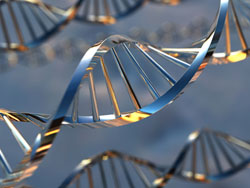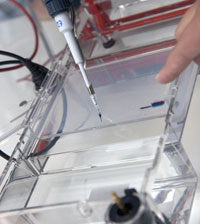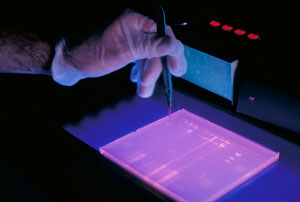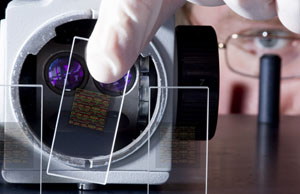
Genetics
Genetic Variation
Genome-Wide Association Studies
Gene Tests
Genetic Research
Comparative Genomics and Evolution
GENETICS

What is genetics?
Genetics is the study of heredity. Genes, made of DNA, are the instruction manuals for making proteins, which combine in many ways to create all the parts of our bodies. Genes are arranged in a defined order in packaging units called chromosomes. Proteins also help to create unique body features called traits. Some traits are visible, like eye color. Others are not, like the ability to fight certain diseases. Scientists who study genetics are called geneticists.
Get More Info:
What is a genome?
A genome is all of the genetic information or hereditary material in an organism. The genomes of individuals within a species are more similar to each other than they are to the genomes of individuals of other species.
Does everybody have the same genes?
Yes and no. While the human genome is mostly the same in all people, slight differences exist. This genetic variation, spread across many genes, makes up about one-tenth of a percent of each person's DNA. Yet these small differences are enough to create people with different appearances and different health. These differences are often inherited, so the more closely related two people are, the more similar their DNA is likely to be.
GENETIC VARIATION
What is genetic variation?
Simply speaking, variation is difference. Genetic variation is a difference in DNA. The “letters” of DNA are molecules called nucleotides: adenine, cytosine, guanine, and thymine (A,C,G,T) strung together in long chains called sequences. The occasional single-letter differences that distinguish DNA among people are called single-nucleotide polymorphisms (SNPs, pronounced "snips").
Does everybody have the same number of genes?
Usually, but not always. A key type of genetic variation is “copy number” variation, which has been observed in identical twins that otherwise have identical DNA. Typically, everyone has two copies of each gene, one inherited from each parent. But scientists are learning that these DNA regions can carry anywhere from zero to more than a dozen copies of a gene. In some cases, researchers have found, one twin's DNA differs from the other's by having different numbers of copies of the same gene. This can affect the gene’s activity level, which can affect traits.

Are there other types of genetic variation?
Yes. Another type of genetic variation that goes beyond differences in DNA sequence is epigenetics. This type of variation arises from chemical tags that attach to DNA and affect how it gets read. The chemical tags, called epigenetic markings, act as switches that control how genes can be read.
Is genetic variation related to health and disease?
Yes. Minor differences in DNA sequence have an effect on health and disease risk. Because parents pass on their genes to offspring, some diseases tend to cluster in families, similar to other inherited traits such as some aspects of physical appearance. In addition, epigenetic markings have been associated with some types of disease, such as cancer. However, it is important to recognize that many factors other than genes, including diet, exercise, and environmental exposures, also contribute to health and disease.
What is a haplotype?
Just as a SNP is a single-nucleotide change, a haplotype is a set of genetic changes-- usually a group of SNPs that tend to be inherited together. Think of a haplotype as a “gene neighborhood.”
What can haplotypes tell us?
Scientists use haplotype information to compare the genes of people affected by a disease with the genes of unaffected people. For example, this approach has revealed a genetic variation that substantially increases the risk of age-related macular degeneration, the leading cause of severe vision loss in older people. The information may be helpful in the future for disease screening and for the development of new therapies.
What about other diseases?
In October 2005, an international scientific team published a catalog of human haplotypes, nicknamed the HapMap. Researchers are looking through the catalog in an effort to identify gene neighborhoods that are linked to susceptibility to many common diseases, including asthma, diabetes, cancer, and heart disease. The information may also help predict gene-related individual reactions to medicines and environmental chemicals.
Get More Info:
GENOME-WIDE ASSOCIATION STUDIES

What is a genome-wide association study?
In genome-wide association studies, scientists look for DNA signposts across genomes of many people to find genetic variations associated with a particular disease. Researchers hope to use genome-wide association study information for diagnosing, treating, and possibly even preventing diseases.
How do scientists perform a genome-wide association study?
Genome-wide association studies are a comparison of same and different. Scientists examine the DNA of two sets of participants: people with a disease under study and similar people without that disease. In most cases, a participant’s DNA comes from a blood sample or from a cheek swab. Automated lab machines read the DNA sequences, and computers look for SNPs and haplotypes that are significantly more common in people with the disease compared to those without it. A genome-wide association study typically uses samples from a thousand or more people.
What can genome-wide association studies tell us?
Recent results indicate that genome-wide association studies are useful for finding the genetic variation linked to common diseases like asthma, cancer, diabetes, heart disease, and mental illnesses. More research is then needed to fully understand how these variations contribute to the development of disease as well as how they may influence the effectiveness of various treatments. With time, as genome-wide scans become faster and cheaper, health professionals may be able to use DNA information to give customized advice—tailored to an individual person’s unique genetic makeup.
Get More Info:
GENE TESTS
What can my DNA tell me?
DNA is really just a biological form of information storage. While your DNA is uniquely your own, researchers do not yet know how that uniqueness translates precisely to individual physical traits like hair color, or countless other features and abilities.
Can I find out the sequence of my own DNA?
Currently, for a sizable fee, nearly two dozen companies offer genetic profiles to individuals. Despite some claims, in most instances such profiles cannot predict an individual person’s chances for getting sick or staying healthy since we do not yet know the influences of specific variations at a deep enough level. What’s more, most profiles don't take into account lifestyle issues, like smoking or an unhealthy diet, which can have a big impact on health. Although medical research is currently pursuing these questions, getting the answers means sampling—and reading—DNA from hundreds of thousands of people from all over the world. This will take many years to understand fully.

What is a genetic test?
In contrast to direct-to-consumer genetic profiles, many certified diagnostic laboratories across the United States offer genetic tests for more than 1,000 disorders. Such tests look for genetic changes that have been conclusively linked to a specific disease through rigorous research. However, it is important to note that doctors usually order a genetic test only if a person has a strong family history of a disease. Even years from now, when researchers know more about the molecular roots of disease, genetic tests may not provide clear-cut answers.
Get More Info:
Then what do the results of a genetic test mean?
Genetic tests may predict whether a person's risk of getting a disease is relatively high, low, or somewhere in between. This is because many factors besides genes, including lifestyle factors such as diet and exercise, also play a role in determining your health.
What is a genetic risk?
Having a genetic risk means that you have inherited the tendency to develop a certain illness. It does not mean that you will develop a particular condition, but rather that you have a higher chance of developing it than if you did not have the risk.
Get More Info:
What is genetic counseling?
Health care professionals known as genetic counselors can be a big help to people who are thinking about getting a genetic test. Genetic counselors go through a rigorous training process in which they earn a master's degree and learn genetics, medicine, laboratory procedures, counseling, social work, and ethics. Genetic counselors do their work in many different settings, including hospitals, private clinics, government agencies, and university laboratories.
Get More Info:
GENETIC RESEARCH
Why does genetic research sometimes involve specific racial and ethnic groups?
Because diseases run in families, many conditions are more common in certain populations, which are sometimes defined as ethnic groups or races. However, members of a given population may be similar in other, non-genetic ways. Non-genetic influences, like diet, climate, and other environmental factors, also tend to be shared within families and within populations.
Get More Info:
Can researchers study my genome without my knowing about it or giving permission?
No. Scientists who conduct research with people are required to follow strict rules that include obtaining signed consent and specifying how the DNA samples will be used. In addition to telling you the purpose of his or her study, a researcher must tell you, before collecting a sample of your DNA, whether and for how long the sample will be stored.
Can researchers share my genome with other scientists?
Only with your permission. Also, to further protect donors, genetic samples that have permission to be shared are often stripped of identifying information, or anonymized.

What is HIPAA?
In 2003, the U.S. Government created a safeguard known as the Privacy Rule under the Health Insurance Portability and Accountability Act, or HIPAA. Most hospitals, doctors, and health plans that have your personal health information must follow the Privacy Rule, which helps protect your personal health information from being used or shared without your permission. Researchers must also follow this rule.
How should people make use of information about their own genes?
Because genetic information is both powerful and incredibly personal, there are deep societal concerns regarding its use. These concerns include the potential for discrimination by health insurance companies or employers who learn about a person's risk of disease. However, to help protect genetic information from misuse, the Genetic Information Discrimination Act, or GINA, was signed into law in May 2008. There are also psychological issues associated with knowing about disease risk. Genetic counselors can help people interpret this information and make health decisions.
Get More Info:
COMPARATIVE GENOMICS AND EVOLUTION
What is comparative genomics?
In an approach called comparative genomics, scientists compare the genome sequences of different species: human, mouse, and a wide variety of other organisms from single-celled fungi to elephants and cows. The goal of this research is to find regions of similarity and difference in order to better understand the structure and function of human genes and thereby develop new strategies to understand, treat, and prevent human disease.

Is comparative genomics related to evolution?
Yes. The main concept in evolution is that all living things share a common ancestor. The very earliest ancestor of all life forms on Earth lived about 4 billion years ago. From that early organism, millions of types of creatures—some living and some now extinct—have evolved. Scientists can study evolution by looking at changes, or variation, in DNA sequence through comparative genomics.
Are human genes similar to those of animals?
Yes. In fact, the DNA sequence of chimpanzees--our closest living relatives--is 96 percent identical to our own. And on average, our genes are 85 percent the same as those of mice, even though these organisms are quite distant from us on the evolutionary tree.
What can evolution tell us about genes and health?
Evolutionary insights can be tremendously powerful for understanding biology and health. By using computer tools to zero in on genes that have been preserved in multiple organisms over millions of years, researchers can locate signals that control how genes work. This information may translate into ways to understand, treat, and prevent human diseases.
Can human genetic research have other benefits?
Yes. As the tools for sequencing DNA get easier and cheaper, comparative genomics techniques have found use in agriculture, biotechnology, and zoology. For example, comparing genomes of similar species may point to new strategies for conserving rare and endangered species of animals. It may also help to enhance nutrient quality of the food supply.
Content created July 2008
